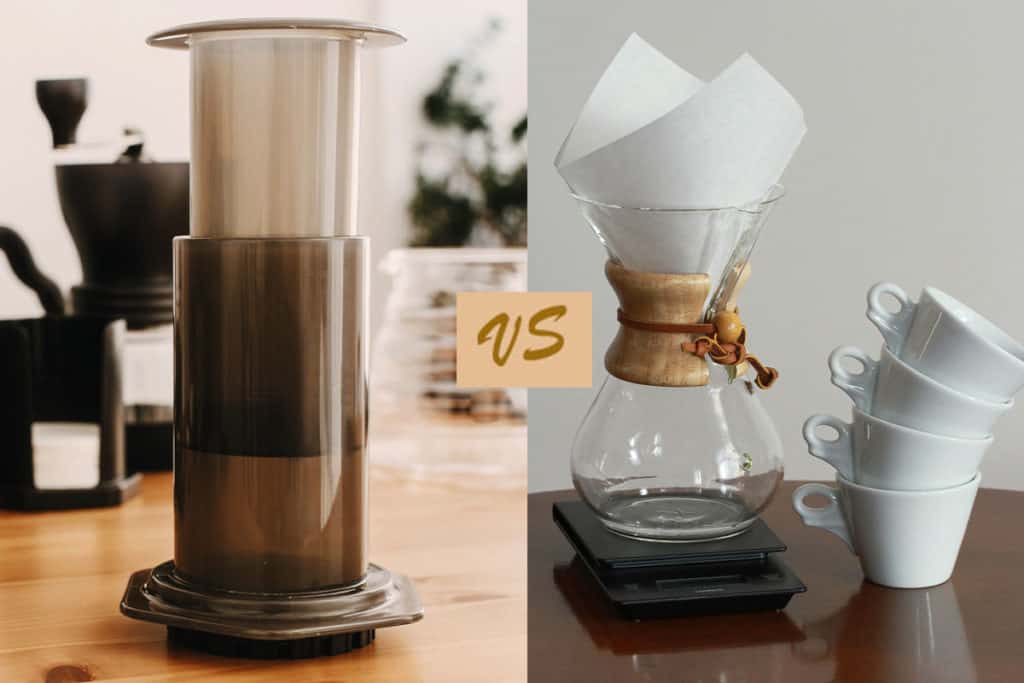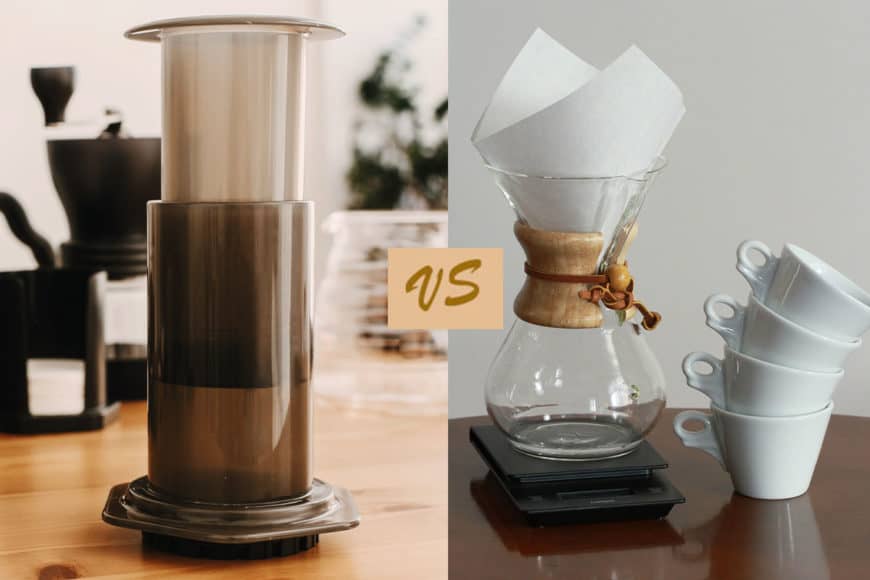
Aeropress vs Chemex – If you are a speciality coffee professional or aficionado, then you probably heard of these two coffee brewing methods. But how do they differ? What practices should you follow in order to make sure you’re brewing a delicious cup of coffee with these two?
Below I’ll look at each of these differences between the Aeropress and Chemex and show you the type of coffee you can expect from them
What is the Difference Between a Aeropress Vs. Chemex
1. Brew Style
When it comes to the main difference between these two brewing devices, the method they use takes center stage. Like we mentioned above, the Aeropress relies on pressure. The water comes in contact with the grounds in a small closed chamber and the extraction takes place once pressure is applied to the brew.
The Chemex on the other hand is a pour-over method. This means that the water goes through a bed of coffee grounds and a paper filter in order to achieve extraction. Let’s find out what that looks like in practice.
2. Brew Time
Since the Aeropress technology allows for pressure in a small chamber, the extraction doesn’t take long and thus the brew time is usually 2 minutes.
The Chemex on the other hand is a pour-over brewing method and depending on the size you use the brew time varies. The more cups you want to make, the more the coffee, the longer the brew time.
3. Grind Setting
Since the brew time of the Aeropress is short, you need to grind your beans on a medium to fine grind setting. The finer the ground the less ground surface the water has to cover, which allows for a faster extraction.
However, the Chemex needs a longer brewing time and this is why you need a coarse grind setting. The ground particles will then be a bit bigger which will slow down the extraction to match the brew time.
4. Filters
The Chemex filters are made from scientifically tested paper that is about 20% heavier than a paper filter usually is. This allows for a clean, bright cup of coffee since the thick paper absorbs all the natural oils from the coffee grounds and results in no sediment in your cup.
For Aeropress you can get paper or metal filters. If you want a clean cup then it is recommended to use two paper filters per brew so they can absorb the oils. If you would like your cup of coffee to have more body then go ahead and use the metal filter, which will allow the oils and sediment to be added in your cup.
5. Portability
A cool aspect of the Aeropress is that it is quite popular for coffee lovers that enjoy being outdoors. It has a reputation for being the number one portable coffee brewer around and it’s widely used by campers around the world.
This inspired the inventor to design the Aeropress Go, a new design that offers a carrying case that can be used as a mug. The Chemex on the other hand is not so convenient to carry around and it is designed to be visually appealing rather than functional for the outdoors.
How Do Brewing Coffee with a Aeropress Vs a Chemex?
Brewing Coffee with a Aeropress
The Aeropress is designed to make one cup of coffee at a time which doesn’t leave much room for experimentation with ratio. First, preheat the Aeropress, your coffee mug and the paper filter you are using.
Measure 17g of coffee beans and grind them using a medium to fine grind setting. Place your paper filter in the filter cap and place it inside the top of the Aeropress chamber. Then, grab the aeropress plunger and place it inside the top of the chamber.
Now you will need to invert your Aeropress so that the plunger is on the bottom and the chamber is on the top. Put your freshly ground coffee in the chamber and place the Aeropress on a scale.
Tare the scales, start your timer and begin adding hot water, aiming for a total of 250ml. If you wish, you can agitate the brew in order for all the grounds to come in contact with the water for a more consistent extraction.
When you are done pouring the water, attach the filter cap with the preheated paper filter to the Aeropress chamber and flip the Aeropress onto your coffee mug.
Begin plunging down slowly, aim for a 20 seconds plunge and make sure you stop once you hear the hissing sound. Hissing occurs when the remaining natural oils of the coffee grounds are being pushed through the paper filter.
I recommend avoiding adding them in your brew because this will result in sediment. Remove the Aeropress from the mug and enjoy your coffee.
Brewing Coffee with a Chemex
The Chemex comes in a few sizes, a three-, six-, eight- and a ten-cup. For the purpose of this article I will give a brew ratio for a three-cup Chemex. Start by heating your water. Grab the Chemex paper filter and place it inside the device. Rinse the filter with hot water.
This will reduce any additional filter flavours and preheat your Chemex at the same time. Pour the hot water out and place you Chemex on your scales. Measure 15g of coffee beans and grind them using a medium to coarse grind setting.
Add the coffee grounds in the paper filter, start your timer and get ready for the first pour. The first pour should be double the amount of water to coffee ratio, in this case 30ml.
This step is called the bloom and it occurs when water is added on the coffee grounds and the carbon dioxide is released resulting in a lot of bubbles. After about half a minute, start adding more water. You are aiming for an overall brew time of about three minutes.
Do not add all the water at the same time, rather try to control it based on your brew time by adding 30ml at a time. This will result in a better extraction. Once you have reached 250 ml of water, stop the pour, remove the paper filter with the coffee grounds, serve your brew in your mug and enjoy your coffee.
Final Thoughts
You can see for yourself that these two brewing methods can differ quite a bit. I came up with a few areas to consider when deciding which one to go with.
If you are making more then just one cup, then Chemex is a better choice. If you are just going to make one cup, then use Aeropress.
If you are traveling or camping, then the ability to throw the Aeropress into any pack make it the better choice.
If you are into cold brew coffee, then the Chemex can makes a tastier cold brew because it yields a very clean cup due to the filter.
All that being said, Once you understand their brewing technology and the different way they can be used in relation to water and coffee grounds, then it’s easy to make a delicious cup of coffee with either of them.

